When it comes to online newsletter creation, Substack is a key player in this space - but is it the right choice for you? This articles takes a look at what Substack is, how it works, and 15 other alternatives for your newsletter.
Key takeaways
- Substack's 10% fees and reliance on constant content creation can lead to burnout and limited passive income potential.
- Whop offers the lowest fees (2.7% + $0.30) while enabling creators to sell diverse digital products beyond newsletters.
- Combining newsletter platforms with community tools like Whop creates multiple revenue streams and reduces platform dependency.
Substack is often seen as the go-to for running a newsletter, but it's not the only way to do it. In fact, there are many reasons why you might want to shop around and find a platform that suits you even better.
From relatively high fees to limited monetization options, Substack has a few shortcomings that could cost you a lot of money. Making money from newsletters is a lot easier and much more scalable if you use Whop.
Below, I'll introduce you to 15 Substack alternatives that I've tried out myself so that you can find the perfect option for your needs.
Why do newsletter creators use Substack?
In the years that passed since Substack was created, it steadily climbed the ladder and won a match or two against its competitors.
Right now, the platform boasts over 3 million paid subscribers and over 30 million subscribers overall, so it has a big reach. That's probably one of the biggest reasons why people turn to Substack, but it's far from the only one.
One of the best things about Substack is that it combines blogging and a newsletter in one, easy-to-use platform. I found the interface to be reasonably simple to follow, and getting started really doesn't take all that long. (If only actually writing the content took that little time…)
You'll find plenty of newsletter platforms and blogging platforms, but there aren't that many 1:1 Substack alternatives. That's a major advantage.
Another good thing about Substack is that it has some built-in monetization options in the form of subscriptions and pledges. Of course, you can monetize your newsletter in many more ways, too. Many creators use Substack as a home for their newsletter but then proceed to make a whole lot more money elsewhere.
Substack's subscription model is a great way to build a semi-reliable source of income. If you can retain your readers, you'll be able to roughly predict how much money you have coming in every month.
However, there are other platforms that offer most, if not all of what Substack can, and some of them do it better.
- How to Create and Launch Your Very First Newsletter in Only 8 Steps
- How Do Newsletters Make Money? 11 Insider Secrets
Where does Substack fall short?
If you ask me, the biggest downside of Substack is that there's no way to make passive income. Once you stop creating for a week or a month, you'll see your subscriber numbers dwindle, and with each lost subscription, you're also losing money.
Burnout is a real thing for content creators, and a subscription model that so heavily relies on constant writing is just not sustainable for everyone. Your readers will expect a certain amount of content on a regular basis and few people will subscribe unless they know you'll be able to provide them with interesting insights every so often.
The other downside lies in the fact that Substack subscriptions are pretty cheap. Sure, you can set yours to be higher than the minimum $5 per month, but many creators keep them affordable. This means that you'll need to sell a huge number of subscriptions in order to make a substantial amount of money.
It's not just that the subs themselves are cheap—it's also that Substack will take a sizeable cut out of them, too. The platform takes out 10% from every sale you make, and then there's also the payment processing fee. As a result, smaller creators don't make much money to begin with, and bigger accounts lose a lot of money to fees.
Don't get me wrong. Despite these shortcomings, Substack is still a good way to start blogging or writing a newsletter. But there are better ways to both let your creativity run wild and to get paid for it, which is what I'll introduce you to below.
15 of the best Substack alternatives
Whether you're looking for an exact copy of Substack or something that can offer you a more comprehensive set of features, I've got you. Check out these top 15 Substack alternatives.
1. Whop
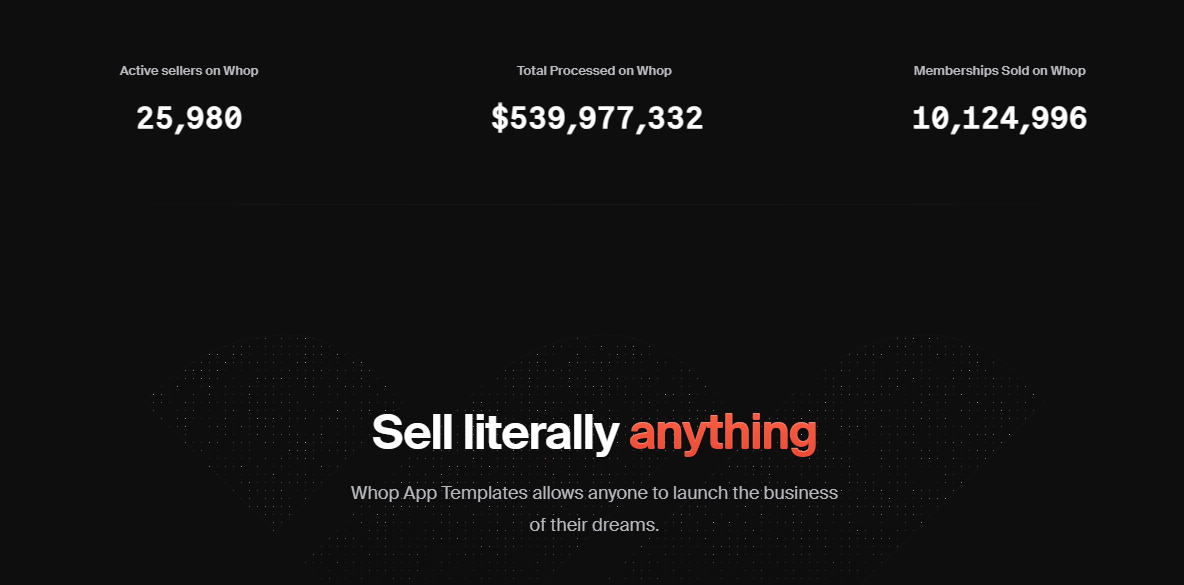
Whop is the best alternative to Substack if you want to get paid for your content, be it newsletters or other digital products. This is because it's as flexible and as limitless as can be.
If your focus is on writing a newsletter, Whop offers Mailmodo integration to help you make it happen right through the platform. Mailmodo is a tool that lets you create and manage email marketing campaigns and newsletters, and by connecting it to your whop, you can turn it into one keg in a well-oiled, robust machine. I'll tell you more about that in a moment, but first, let's see what Mailmodo can do for you.
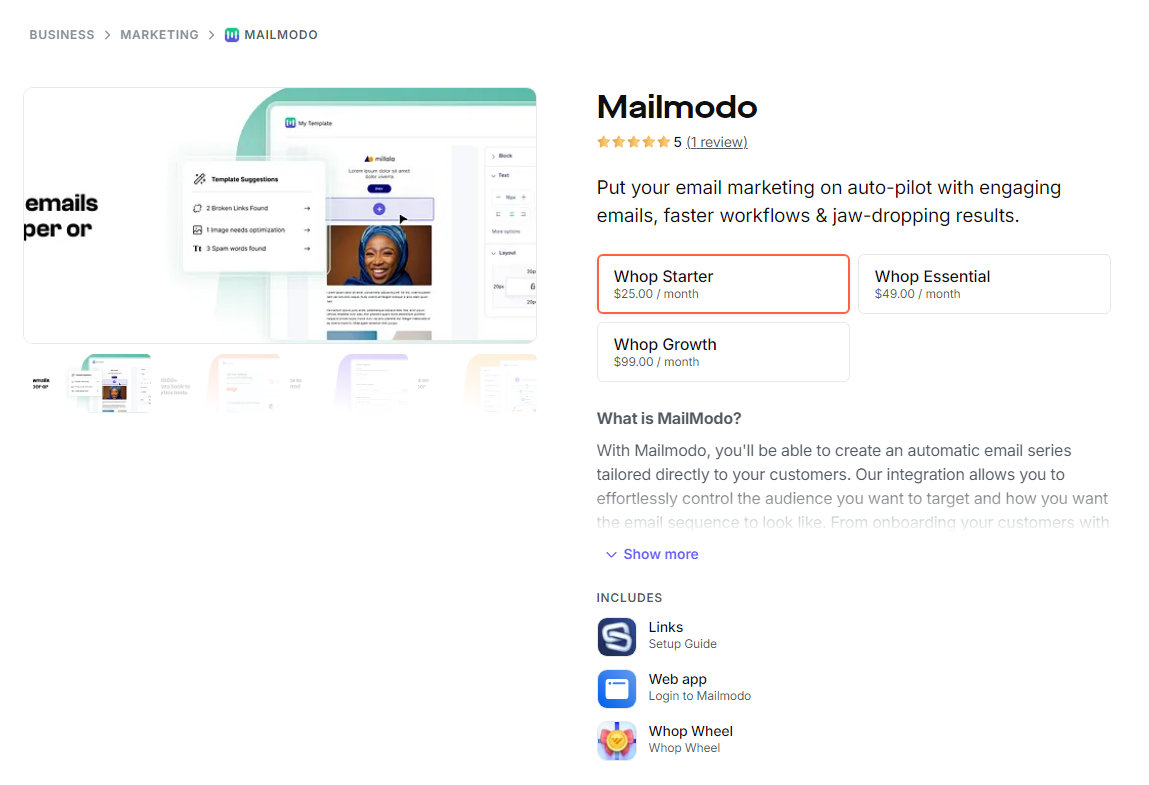
Mailmodo helps you build your emails from scratch. It comes with all the tools you need to make your newsletter, including an email builder and widgets, as well as crucial options for sending, managing, and tailoring the emails you send.
If you have an existing mailing list, Mailmodo lets you import bulk contacts and add your own domain, so the move will be seamless and simple. You can also sync contacts from other platforms, and useful integrations like Whop and Facebook make it easier to both advertise and scale your newsletter.
The best part of using Whop is that you don't need to use Mailmodo if you're not ready to leave your existing platform. Instead, you can use Whop to level up your newsletter with even more content for your subscribers.
With Whop, you're not bound to stick to newsletters. You can use your newsletter, be it through Mailmodo or through another Substack alternative, as a sales funnel for the rest of your products.
Use Whop to sell any of the following:
- online courses
- one-on-one calls
- ebooks
- live events
- webinars
- downloadables, such as worksheets or templates
- access to an exclusive community for your readers
- SaaS
- access to exclusive content, such as members-only blog posts
- all sorts of other digital products
You can set up your whop in just a few minutes, and from there, set pricing tiers and bundles to make the most of your content. Whether you send your newsletters directly through Whop or use it as a way to supplement another platform, you're building a full-on community platform. Whop helps you create and evolve your brand while supporting you every step of the way.
Pros:
- Mailmodo integration lets you send and manage newsletters
- Whop has some of the lowest fees of any platform on this list
- You can create a comprehensive, all-in-one platform for your readers
- Sell all sorts of digital products, from ebooks to courses
- Tiered pricing lets you tailor your offer to every customer
Pricing: On Whop, pricing depends on how you use the platform. Without being listed on the Marketplace, you can still use Whop to its full potential, and the platform only takes a 2.7% + $0.30 fee plus payment processing fees. This means you retain up to 97% of each sale, minus the cut that Stripe takes for the transaction.
Using Whop is entirely free and it doesn't require any upfront payments, so you can start out with no investments and see how you like it.
2. Ghost

Ghost is a publishing platform for independent journalists. It's open source and the people behind it are part of a non-profit organization. It's built to help writers build their own websites, publish content, and even send out newsletters and provide paid subscriptions.
Ghost has been around since 2013 and it has a few big names on the platform like Ali Abdaal (a YouTuber with 5 million subscribers) and David Sirota (writer of Don't Look Up). Newsletters are built right into the platform, allowing you to send updates to your subscribers whenever you want. You can also send out different newsletters to different segments of your audience based on what they like.
You can choose from hundreds of themes for your website or even build one completely from scratch, so you can add plenty of branding if that's your thing. The content publisher itself is also easy to use and pretty robust—you can add image galleries, gifs, video, audio, products, downloadable files, and more to your posts.
Pros:
- Fully customizable websites and hundreds of themes to choose from
- Built-in newsletters to send updates by email
- See who your members are, whether they pay, and what they read
- Built-in engagement analytics
- Offer promotions and sales on subscriptions
Cons:
- Subscription price is tied to membership numbers
- Monthly prices can get high
Pricing: There are four subscription tiers available: Starter, Creator, Team, and Business. If you're running your own side business, you probably need Starter or Creator because they're aimed at one-person operations.
The price of each subscription is tied to the number of members your community has. When you're starting out, for example, the Starter tier costs $9 a month for up to 500 members. If you reach, say, 3,000 members, you'll need to upgrade to the Creator tier and pay $40 a month. There's a slider on the pricing page so you can see how the price changes with more members.
3. Patreon

Patreon is a well-known platform for creating paid communities. It offers a way for creators to develop a stable income without having to worry about social media algorithms and ad revenue.
For newsletter publishers, you can combine a Patreon community with an existing website or newsletter platform but you can also sell digital products directly on Patreon. Recommended product types to sell include video, audio, images, and downloadable files.
It might not suit your newsletter business model perfectly, but it could allow you to sell a few new or special products easily. Patreon is best known for its customizable membership tiers, allowing you to offer plans at a range of prices with all kinds of different perks.
Pros:
- Patreon is recognizable
- You can offer several membership tiers
- Free to set up
Cons:
- Takes a huge percentage of your overall income
- Not optimized for sending out newsletters
Pricing: Pateron has two paid membership tiers: Pro and Premium. The Pro tier will cost 8% of the income you earn on Patreon plus payment processing, currency conversion, and payout fees. The Premium tier offers a few extra perks for bigger teams but takes a 12% cut of everything you earn.
If you sell digital products with Patreon, you'll also pay 5% of your monthly sales earnings along with the applicable fees.
4. Mailchimp

If email newsletters are the core of your business, Mailchimp is one of the most well-known platforms for managing email marketing. It's used by all sorts of big names and is highly scalable—so if your newsletter blows up, you won't have any problem dealing with all your new subscribers.
The service has customizable tools for creating newsletters, including templates and a drag-and-drop builder for quick creation. It also offers a range of automation tools so your emails go out exactly when you need them to without having to hit send yourself.
Clicks and reads are all tracked so you can see how people are engaging with your newsletters, and you can try out new things with A/B testing and other research strategies.
While it can help you create and send out beautiful newsletters, Mailchimp won't help you with the payment side of things. You'll have to use your own website to allow people to sign up and pay for your newsletter, which is why using Whop with the Mailmodo integration might be easier.
Pros:
- Professional-level email marketing tools
- Scalable
- Lets you automate your newsletters
- Built-in analytics
Cons:
- Used by big businesses so the prices can get high
- You'll need another platform for sign-ups and payments
Pricing: Mailchimp has a Standard plan and a Premium plan. The Standard Plan lets you send up to 6,000 emails every month and its price depends on how many contacts you'll send them to. For 500 contacts, for example, it costs $20 per month. For 5,000 contacts, it would cost $100 per month.
Premium works the same way, but you can send up to 150,000 emails a month to a minimum of 10,000 contacts for $350 a month. For 25,000 contacts, it would cost $620 per month.
5. HubSpot

HubSpot creates software products for marketing, sales, and customer service—and this includes email newsletters. Like Mailchimp, you can use HubSpot's newsletter tools to build and automate your newsletter and track your results with built-in analytics.
With the newsletter builder, you can create a newsletter just by choosing a template and drag-and-dropping elements into the right places.
HubSpot also has tools to create personalized newsletters even if you're sending to hundreds or thousands of people. This means you can add people's names or include personalized elements based on the data you have on your subscribers.
The analytics then tell you how many newsletters you sent, how many were opened, and how many clicked on links in the newsletter. If you want to improve things, you can try out features like A/B testing to see which newsletter versions perform better.
Pros:
- A free version is available for when you're starting out
- Easy-to-use newsletter builder
- Built-in analytics to track who is reading your newsletters
Cons:
- Not an all-in-one platform for monetizing your newsletters
- Must be used alongside other apps and tools
- Gets expensive if you have a big audience
Pricing: HubSpot has a free tier that includes its newsletter tools, so while limited, you can try it out. The paid tiers start at $15 a month for tools with increased limits and customer support. The paid tiers also come with 1,000 marketing contacts to help get you started with reaching out to new people.
6. Gumroad

Gumroad is an ecommerce platform where you can sell both physical and digital products. It works well for newsletter publishers because you can sell tiered memberships on the platform and use email tools to send out custom emails to different tiers.
You can also give your subscribers the option to "tip" you or pay more for your product by allowing them to pay a custom amount above a minimum price.
If you want to expand beyond newsletters, you can add new types of physical or digital products to your store, including commissions and services. Making a store with Gumroad means new people can find you on the Gumroad market, which also recommends products to customers based on their preferences and showcases featured products.
Pros:
- Lets you sell newsletter memberships and send out newsletters with one platform
- You can expand into other kinds of products on the same platform
- Easy to send different newsletters to different members based on tiers
- No membership fees
Cons:
- Takes a cut of every sale
- If the sale is made through the Gumroad app you have to pay both Gumroad and the App Store/Google Play Store
Pricing: You don't have to pay a membership fee to sell products on Gumroad, but it does take a percentage of every sale. It's a 10% flat fee which can be considered quite high.
If someone purchases the Gumroad app, you're the one who has to pay the fee to the App Store or Google Play Store on top of Gumroad's fee. This means you'll lose 40% of your sales to fees. Lots of people make purchases through the app, so this is definitely something to think about.
- HubSpot vs Mailchimp: Which is the Best Fit for Your Business Needs?
- What is Gumroad and How Can Creators Use It?
7. WordPress

WordPress is a well-known website and blog hosting platform that's used by a range of big names like Meta and Samsung. It provides you with tools to make a custom website where you can post content, sell digital products and memberships, and ship paid newsletters.
While WordPress does work with enterprise customers, it also offers plans for individuals or small businesses so even beginners can use it. You can also import content from a different platform to WordPress if you decide to switch. You can also take your content and your subscribers with you if you decide to use a different platform in the future.
You can create a landing page for your newsletter and use templates to make the newsletter itself. Many platforms either choose the membership fee route or the income share route, but WordPress actually requires both. You need to pay a membership fee to build and host your website, and the company will also charge transaction fees whenever you get a customer.
Pros:
- Easy-to-use website builder and built-in newsletter tools
- Multiple ways to monetize your blog and email content
- Your subscribers belong to you and you can always migrate to other platforms
- Plans available for both small and big businesses
Cons:
- Need to pay both a membership fee and transaction fees
- Not focused on email marketing
- Fairly steep learning curve
Pricing: There are five membership tiers in total: Personal, Premium, Business, Commerce, and Enterprise. Unless you're heading your own big business, you'll probably only need Personal, Premium, or Business. The higher the membership fee you pay, the smaller the transaction fee will be. For example, the Personal membership fee is $4 a month with an 8% transaction fee, while Premium is an $8 membership fee with a 4% transaction fee.
8. Moosend
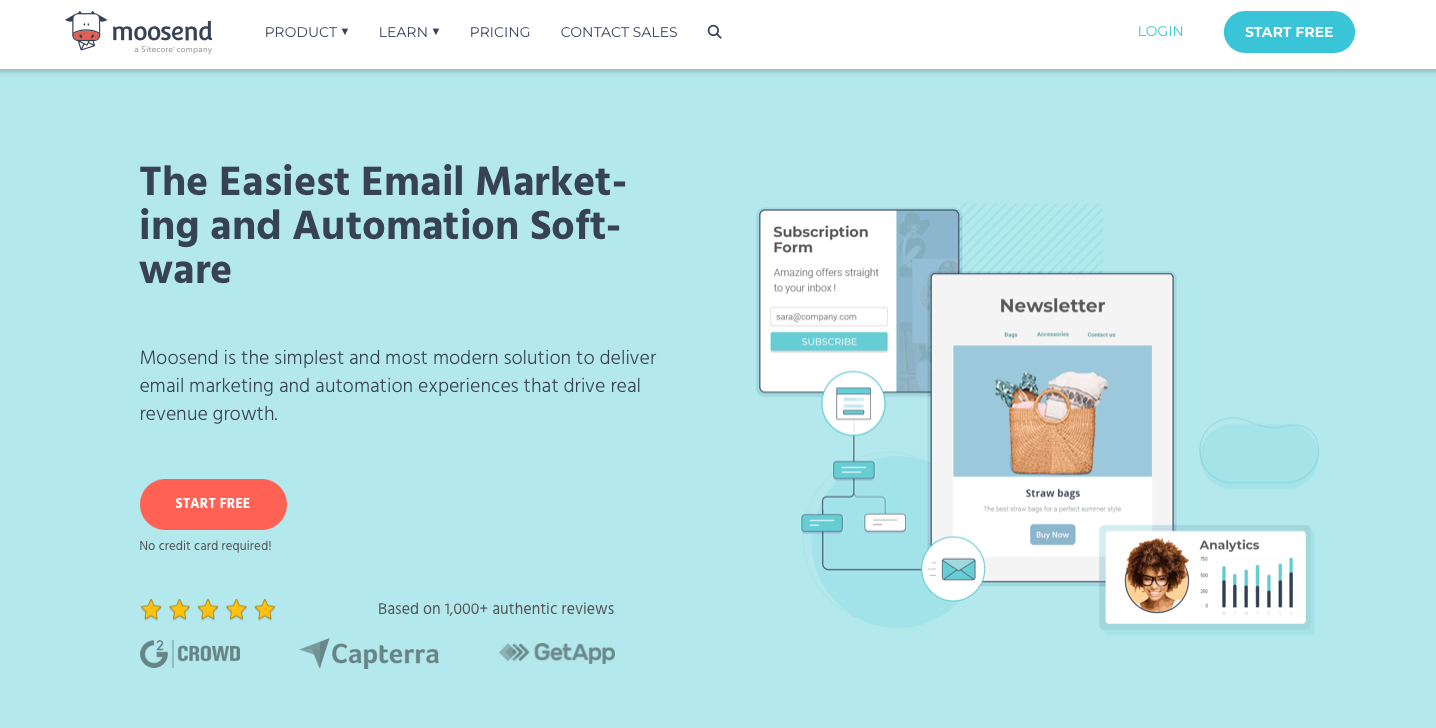
Moosend is an email marketing and automation software that can help you build custom newsletters and send them out to your subscribers. A lot of its features are more aimed at ecommerce stores that send out newsletters to convert readers into customers, but you can still use it if newsletters are your main product.
Like other marketing software, it focuses on newsletter templates, email automation, and analytics. So if you want to use it, you'll need to find a different platform to make and host a website where you can sign subscribers up and take care of payments.
One good thing about the platform is that you can create your own custom membership and only pay for the features you actually need.
Pros:
- Build your own membership
- Try it out with a free trial
- Drag-and-drop newsletter builder
Cons:
- Only takes care of building and sending newsletters, not selling memberships
- No features specially for paid content
- No native payment processing
Pricing: There's a free trial available that lets you try all the core features for 30 days. After that, you can either sign up for Pro for $7 a month to get unlimited emails or build your own membership with all the Pro features plus whatever add-ons you want. There isn't a set price for this because it depends on which and how many add-ons you choose.
There is also an Enterprise tier for bigger customers which also allows you to customize the features you pay for.
9. Kit

Kit (formerly ConvertKit) focuses on business growth through email marketing, but it also offers a host of other newsletter-related features. For instance, you can create a micro website where you can list your products or membership tiers. It's a smaller and lighter version of a website for creators who only want a landing page.
Other creators on the platform can add you to their recommendations list, which is a lot like what Substack offers. You can recommend others too and get paid for it when one of your members subscribes based on your recommendation.
There are lots of different ways you can organize your audience, for instance, by their interactions or interests, so you can send personalized content to people and provide an even better experience.
Pros:
- Find subscribers, get paid, and send out content all in one place
- Benefit from recommending and being recommended by other creators
- Opt into ads to make more money
Cons:
- The more subscribers you have, the more you pay
- Limited automation features in the free plan
- Paid plans are relatively expensive
Pricing: Kit has three membership tiers: Newsletter, Creator, and Creator Pro. Newsletter is a free tier for anyone with less than 10,000 subscribers.
The cost of the paid tiers scale depending on how many subscribers you have. For 15,000 subscribers, for example, Creator costs $125 per month and Creator Pro costs $175. If you're working on the Newsletter plan and you have over 10,000 subscribers, Kit will automatically upgrade you to Creator.
10. MailerLite
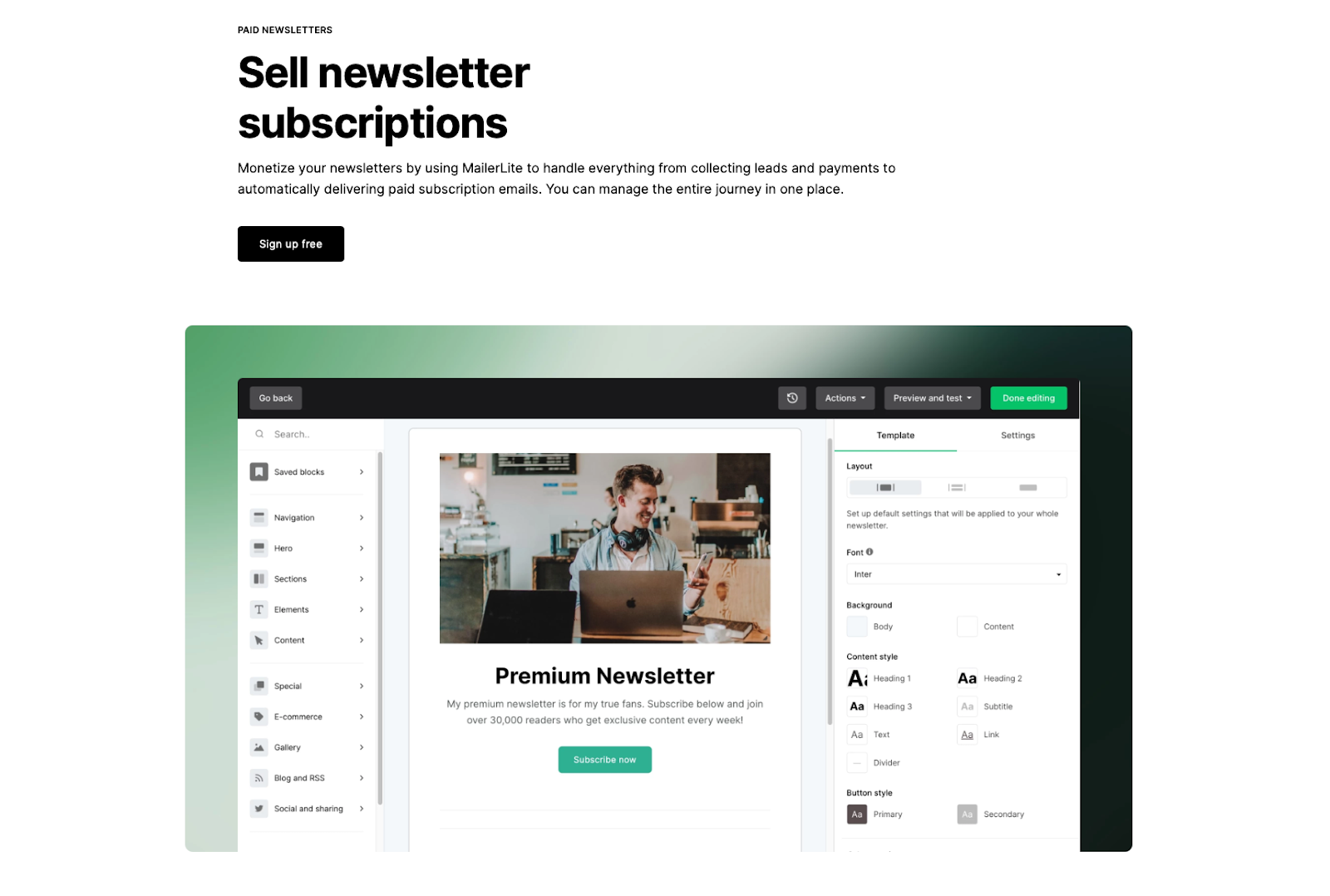
MailerLite is an email marketing service that lets you create and sell paid newsletters. It can handle everything from collecting leads to settling payments and delivering emails. You can use the drag-and-drop editor to create a landing page, subscription form, or a website for your newsletter.
Payments are taken care of through Stripe integration and you can choose from one-time payments or weekly, yearly, or custom subscriptions. There are also tools for building your newsletter which let you choose from a variety of elements like surveys, quizzes, image carousels, and more.
You can use A/B testing to figure out what your audience likes and check the results with built-in analytics.
Pros:
- Sell and deliver newsletters with one platform
- Create a website (if you want to)
- Choose from lots of payment options
Cons:
- The more subscribers you have, the more it costs
- Limited analytics compared to other platforms
- Free plan is limited
Pricing: You can use the free tier while you have less than 1,000 subscribers—at that point, you'll need to start paying. The Growing Business tier costs $13.50 a month at 1,000 subscribers but the price goes up as your subscriber list goes up. The maximum is $260 a month for up to 50,000 subscribers. If you go past that, you'll need the Advanced tier which can handle up to 500,000 subscribers.
11. Buttondown
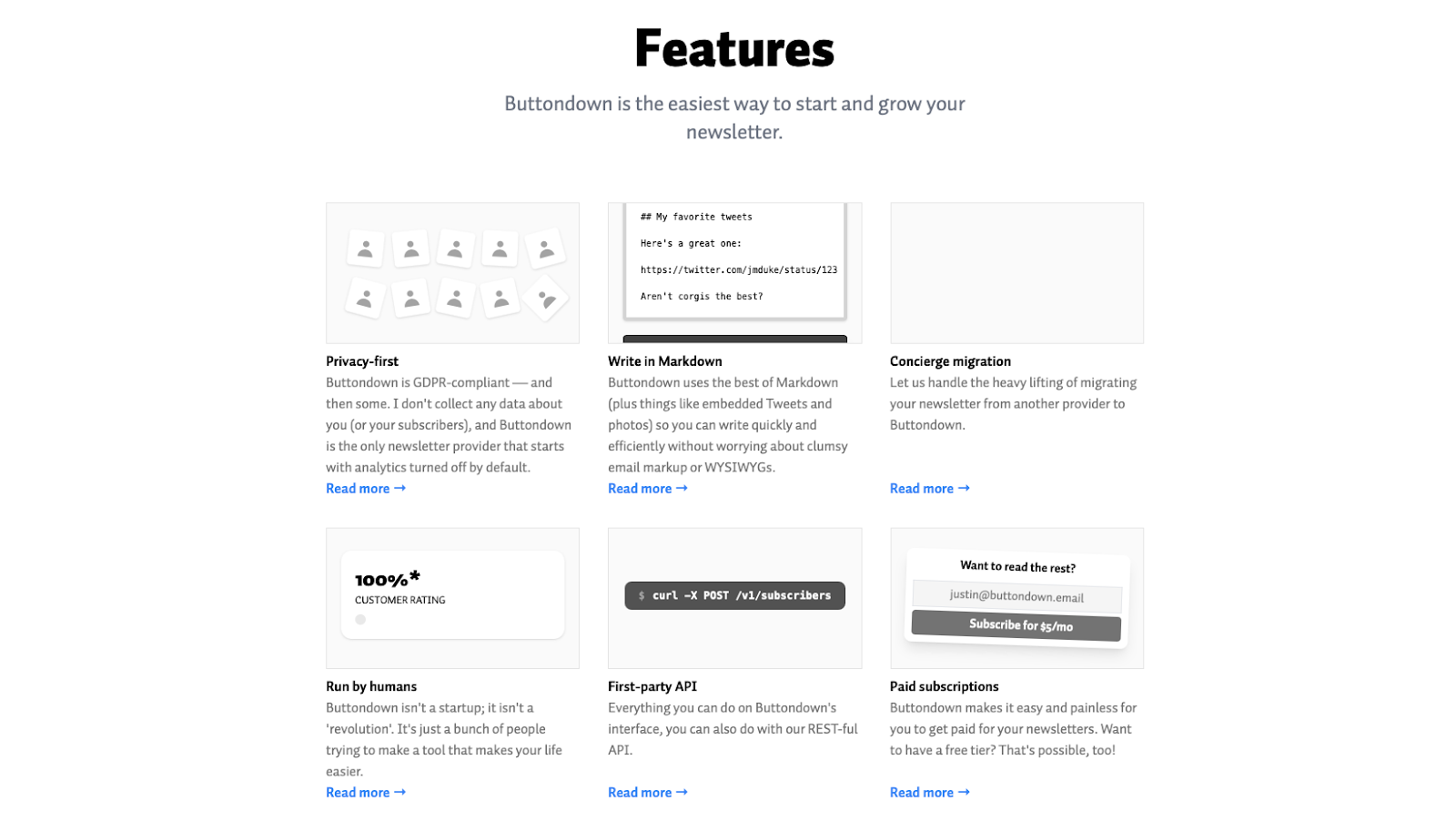
Buttondown is a smaller company that focuses 100% on email newsletters. The company puts a lot of emphasis on providing stable services for a good price because many email services branch into other industries and sometimes even move away from email.
You can offer paid subscriptions with different tiers and let subscribers choose what they want to pay for your content—similar to Substack's pledge system. You also own your subscriber list so you won't lose them if you move to a different platform.
Other features available include custom domains, newsletter archives, free migration, tagging and segmentation, analytics, email attachments, and the option to send multiple newsletters.
Pros:
- Simple and focused features
- Ability to offer paid subscriptions for your newsletter
- No transaction fees
Cons:
- Only offers newsletters
- No scalability
Pricing: Buttondown is free for your first 100 subscribers (though the tools you can use are limited). For 1,000 subscribers, it costs $29 a month or $290 for the year and this price gets higher based on how many subscribers you have. Once you hit 100,000 subscribers, you'll have to talk to the team to arrange a custom quote.
12. Flodesk
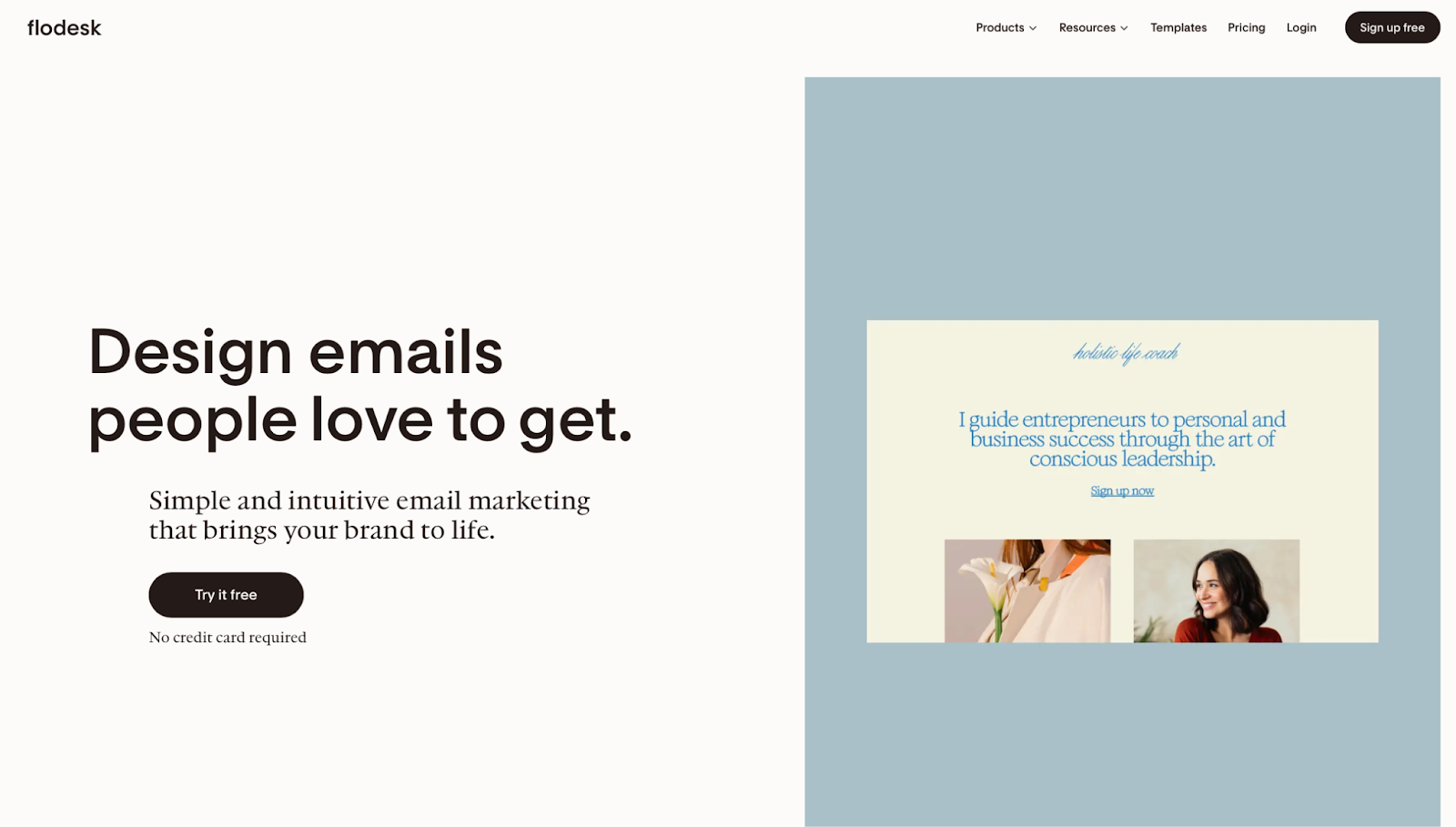
Flodesk offers email marketing software similar to MailChimp or Kit. You can use a range of templates to create newsletters or create your own templates to reuse. You can also create subscription forms that ask subscribers questions about what they're interested in so you can segment your audience and send more personalized content.
With specific tiers, you can also access robust analytics and automatons, along with developer tools to customize your experience.
Pros:
- Unlimited subscribers and emails
- Segmenting and workflow automation
- Integration with popular tools
- Flat pricing
Cons:
- Limited feature for advanced users
- No A/B testing
- No built-in payment processing
Pricing: Flodesk has a limited free tier for people to try out the service and features but if you want to use it properly you'll definitely need to pay. The flat rate is $35 per month and stays the same as your subscriber list grows.
13. Buy Me a Coffee

Buy Me a Coffee is a platform based around the idea of supporting creators, no matter what they do. It was originally used so fans could support YouTubers and other creators whose content people consumed for free, but it has expanded since then.
The platform now includes the Shop features which allows creators to sell digital products like video calls, art commissions, or ebooks. It also includes email marketing tools, which means you can sell memberships and send out emails to those members—making it usable for newsletter publishers.
Pros:
- No monthly fees
- Multiple payment options
- Support for digital downloads
- Integrations with popular platforms
Cons:
- Limited customization for newsletters
- Advanced management features like automation and segmentation aren't included
- Less branding control
Pricing: Buy Me a Coffee doesn't charge a monthly fee; instead, there is a 5% transaction fee every time someone makes a purchase. There are no additional tiers or plans available, it's just the same transaction fee for everyone.
- What is Buy Me a Coffee, and How Can You Monetize With It?
- Substack vs Medium: Which Digital Publishing Platform is Best?
14. Medium

Medium is a popular online publishing platform where people can share articles and stories.
You can earn through its Partner Program, which pays based on member reading time. It also allows for paid newsletters that subscribers pay for via a monthly or annual fee.
The platform handles email distribution for paid newsletters, so you can reach your audience without needing separate tools.
Newsletters are more of a way to promote the content you post on Medium, however, so it doesn't work the same way as a platform that helps you set up a paid newsletter subscription.
Medium pays writers based on reading time and engagement, with writers typically earning between $2.50 and $9 per 1,000 views, but some people earn a lot more.
Pros:
- Built-in audience
- Simple monetization
- Medium articles rank well on search engines
Cons:
- Lack of customization
- Lots of competition on the platform
- You don't get full access to subscriber data
- Low earning potential
Pricing: You can become a member of Medium for $5 a month, and after you've published one story, you can apply to the Partnership Program to become eligible for monetization.
15. Beehiiv
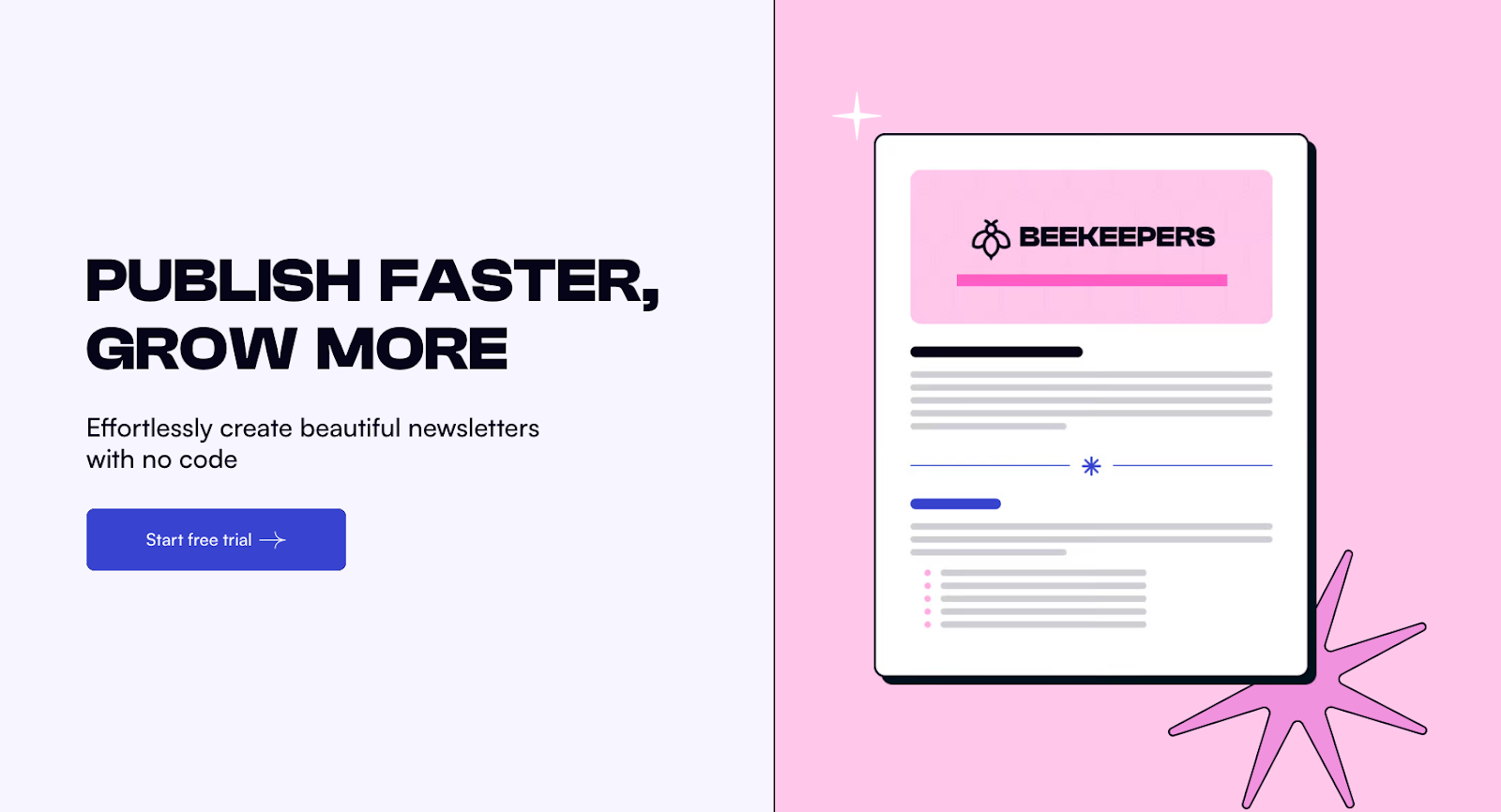
Beehiiv was created by the team behind Morning Brew, a popular newsletter for world events.
It includes a range of templates for creating newsletters alongside advanced analytics, a referral program, audience polls, premium-only content, custom merge tags, ad integrations, and social sharing.
It's also designed as a drag-and-drop interface so you don't need to write any code to create and send out newsletters.
Beehiiv lets you keep tabs on your audience with various analytics options, including open rates, click-through rates, and demographics. You can also lean into audience segmentation to make sure your newsletters only reach the people who care about a particular topic.
Pros:
- User-friendly
- Tools for growth, audience segmentation, and advanced analytics
- Built-in monetization
Cons:
- Newer platform so features are a little limited
- Only offers features for newsletters, with no other products to expand into
- Can get expensive
Pricing: You can get started for free with the Launch tier and keep using it until you hit 2,500 subscribers or want to expand the set of tools available to you. The paid tiers are scaled according to how many subscribers you have. For example, the Scale tier costs $69 a month for 5,000 subscribers and $131 a month for 25,000 subscribers. The Max tier costs $130 for 5,000 subscribers and $218 a month for 25,000 subscribers.
What to look out for when choosing a newsletter publication platform
Now that you know the 15 best Substack alternatives, your head might still be spinning with options. I know, I know—there's a lot to choose from, but that's a good thing.
The reason why I'm giving you more than one platform to choose from is that there are no one-size-fits-all solutions. Some platforms will fit your needs and others won't. Now, the key is figuring out which one is the right option for you in particular.
When making your decision, make sure to consider the following:
- Monetization. Even if you're not doing this for the money, you deserve to get paid for your hard work! Look into the monetization side of things and make sure that the platform you're choosing lets you get paid, be it little thank-you gifts or full-on subscriptions.
- Pricing. This ties in with the point above, because if there's monetization, there are fees. How big a cut does the platform take out of every dollar you make? Do you need to pay for access, or do you just share your revenue? Remember that if you choose a platform that requires subscriptions, you might be losing money for the first few months while your newsletter or blog takes off.
- Analytics. Knowing what does well and what doesn't is the key to creating a successful newsletter. Your platform of choice should provide you with lots of analytic tools, including click-through rates, open rates, and full demographics.
- Scalability. Only selling newsletters and blog posts can only get you so far, and many platforms don't support branching out. The perfect platform will help you sell more than just written content, allowing for much higher rates.
- Customer management. Let's say you're monetizing your newsletter—that's great! But what if something goes wrong? Tech doesn't always work the way we want it to, and if there's a problem with payment or granting access to the newsletter, who's going to do that for you? You want a platform that handles all of this so that you can save time and focus on creating new posts to share.
- Discoverability. Platforms without a marketplace or a recommendation system are difficult to get started on. If you're new to publishing a newsletter, you might be better off using a platform where your content will be seen by many eyes.
- Upfront investment. Having to pay a subscription is a difficult choice if you're just starting out, and some newsletter platforms charge an arm and a leg once you've got more subs. That's why it's a good idea to consider a platform that's free to start and lets you grow at your own pace.
Take your time to consider your new digital home and pick the platform that works with you, and for you, every step of the way.
Create and sell premium content with Whop
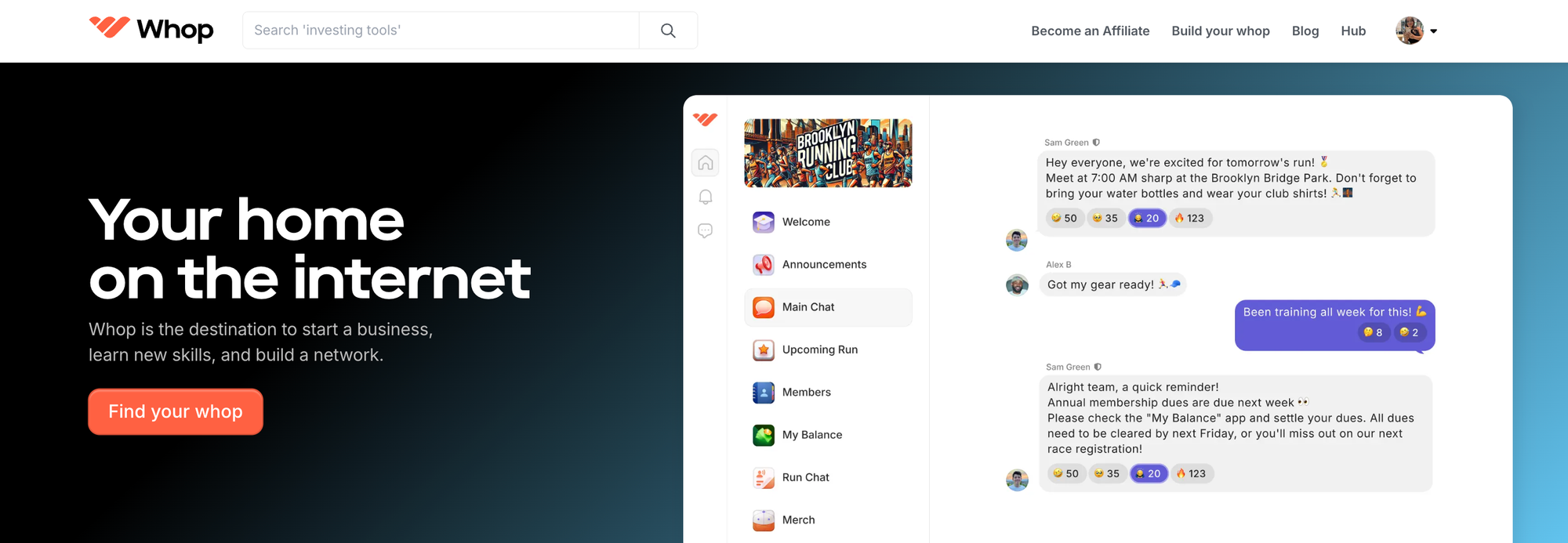
As a content creator, your main job should be to create. You've got thoughts to share; analytics to take into consideration; marketing plans to put in motion.
With your hands full of the "creation" side of the business, you shouldn't have to figure out a way to make all of this happen. Running a blog or a newsletter shouldn't be a struggle, and your digital toolkit shouldn't include several different apps. The right platform will help you focus on what's important and support your goals, big or small.
This is why, if you're looking for a Substack alternative, look no further than Whop. With Whop, you can make money from your newsletter or blog in a number of ways:
- You can use the Mailmodo integration to send out newsletters directly.
- You can publish posts directly on your very own whop.
- You can level up your existing newsletter by offering exclusive content at a premium.
There's a lot of money to be made from ebooks, online courses, or setting up an exclusive community for your followers. With Whop, you can do all of the above and more while staying in touch with your readers.
Whop automates the whole process for you. You won't have to worry about granting people access to your content or finding new ways to upload an ebook or some extra files. You've got it all right there within Whop.
Shift your focus to creating and get paid for your content with Whop.
FAQs
What's similar to Substack?
Platforms that work in a similar way to Substack are centered around helping you publish newsletters or blogs. This includes Ghost, ConvertKit, MailerLite, and Whop. For the latter, you can use the Mailmodo integration to manage your newsletters, while also selling other products to make more money, such as ebooks or courses.
What is the downside of Substack?
Some of the downsides of Substack include limited customization options and a lack of advanced marketing tools. Moreover, Substack charges a fairly hefty fee for every subscription, taking a 10% cut. It also has fairly few options to monetize your content.
Can you make money with newsletters?
Yes, you can make money with newsletters, but it's even better to branch out and collect revenue from a few things at once. To monetize a newsletter, you can set up a tip jar, try affiliate marketing, charge a subscription, or advertise digital products like your own ebooks or online courses to make extra money.


